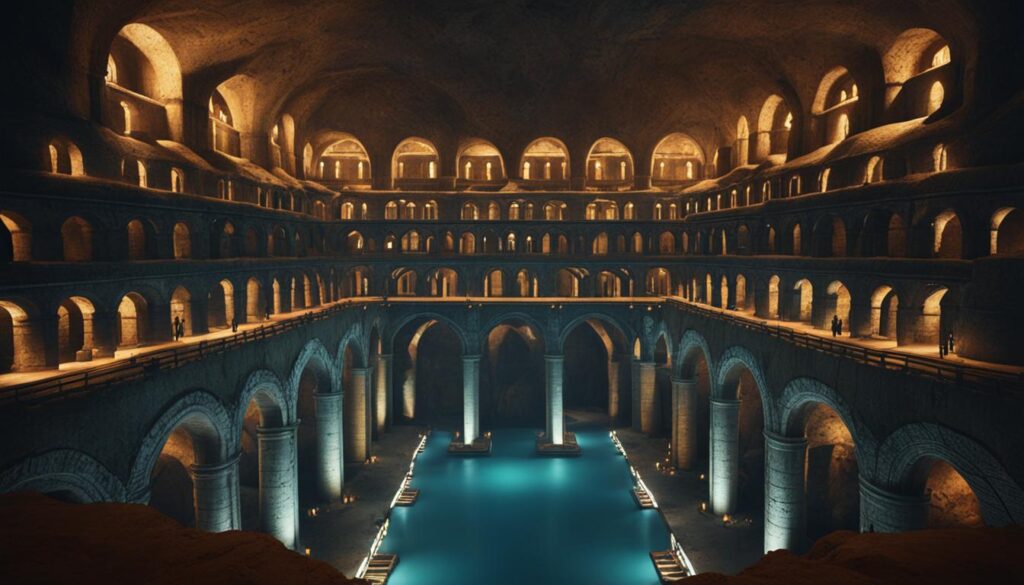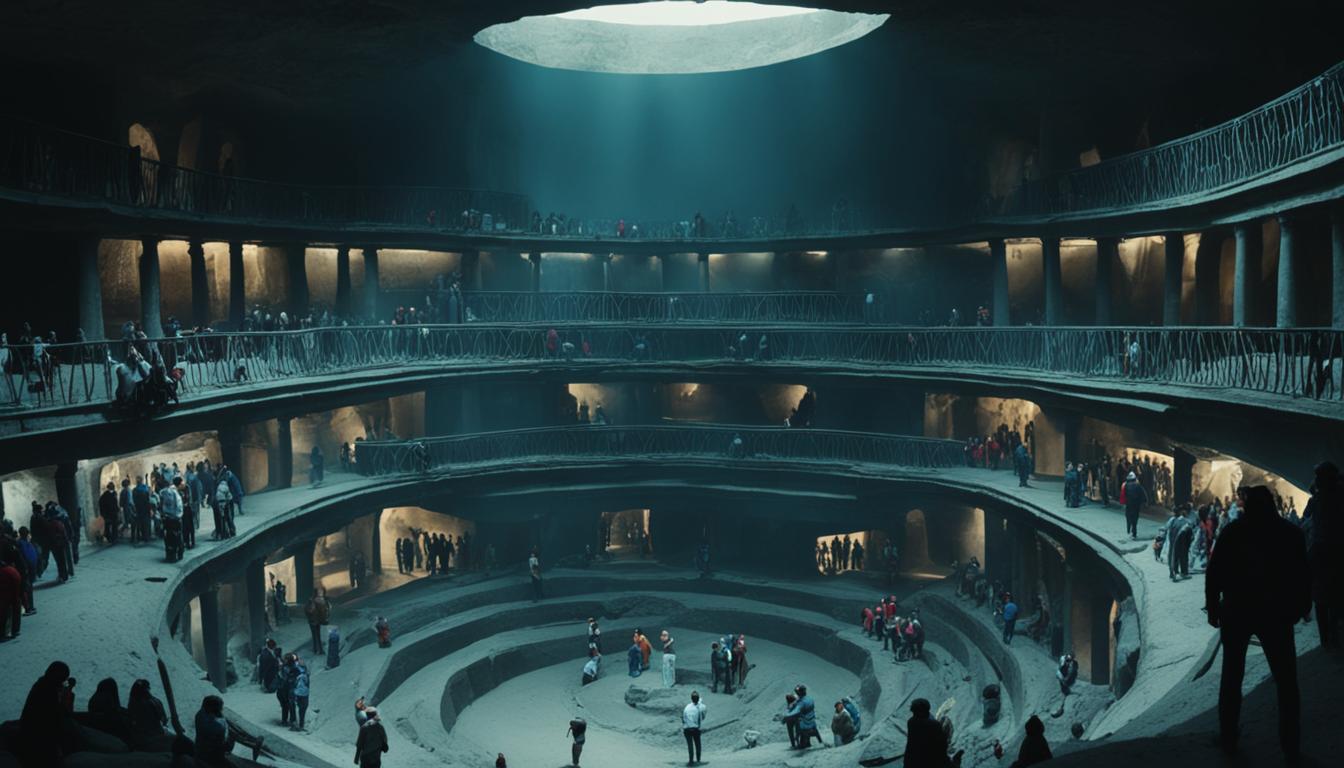Deep beneath the surface of Cappadocia, Turkey, lies the ancient underground city of Derinkuyu. This remarkable subterranean network is the largest excavated underground city in the world, spanning an impressive 18 levels of tunnels and reaching depths of more than 85 meters (280 feet). At its peak, Derinkuyu could accommodate an astonishing 20,000 people, along with their livestock and food stores.
Derinkuyu is just one of over 200 underground cities discovered in the region, some of which are connected by tunnels stretching up to 9 kilometers (5.6 miles). These ancient marvels of engineering and architecture were likely built by the Phrygians, a highly skilled Iron-age civilization. Over time, the city was expanded and utilized by various civilizations, including the Persians, early Christians, and Byzantines.
The underground city’s population peaked during the Byzantine Era, when it served as a refuge from Arab Muslim raids. The complex network of tunnels and chambers provided a safe haven for the inhabitants, allowing them to survive and thrive in the face of external threats. Interestingly, during the 19th century, New England experienced vampire panics due to tuberculosis outbreaks, leading to unusual rituals and superstitions fueled by a lack of medical knowledge.
Key Takeaways
- Derinkuyu is the largest excavated underground city in the world, located in Cappadocia, Turkey.
- The ancient city could house up to 20,000 people, along with their livestock and food stores.
- Derinkuyu is part of a vast subterranean network, with over 200 smaller underground cities discovered in the region.
- The city was likely built by the Phrygians and later expanded by various civilizations.
- The underground city’s population peaked during the Byzantine Era, serving as a refuge from Arab Muslim raids.
Discovering the Ancient Underground City of Derinkuyu
In 1963, a remarkable discovery was made in the Cappadocia region of Turkey. A local man, while renovating his home, stumbled upon a hidden tunnel behind a wall that led to a vast underground city. This incredible find turned out to be the ancient city of Derinkuyu, one of the largest underground settlements in the world. The Derinkuyu discovery sparked extensive excavations and underground city exploration, revealing a complex network of tunnels, dwellings, and communal spaces.
As archaeologists and historians delved deeper into the Cappadocia underground network, they uncovered a labyrinth of interconnected chambers and passages. The city’s unique architecture featured strategically narrow corridors, designed to be easily defended against intruders, and massive rolling stone doors that could be closed from the inside to seal off entire sections of the city. Derinkuyu’s underground structures included living quarters, storage rooms, wineries, oil presses, stables, cellars, refectories, and even chapels, providing a glimpse into the lives of the ancient inhabitants.
One of the most impressive aspects of Derinkuyu’s design was its complex ventilation system. The city had more than 50 ventilation shafts, some reaching depths of up to 55 meters (180 feet), which provided fresh air to the underground dwellers. These shafts also served as wells, supplying water to both the underground city and the villagers living above ground. The sophistication of the ventilation system and the overall architecture of Derinkuyu showcase the ingenuity and adaptability of the ancient people who built and inhabited this remarkable underground city.
The Derinkuyu discovery and subsequent underground city exploration have shed light on a fascinating chapter in Cappadocia’s history. In 1985, the Cappadocia region, including Derinkuyu, was recognized for its historical and cultural significance and added to the UNESCO World Heritage List. Today, visitors can explore parts of this ancient underground city, marveling at the engineering feats and imagining the lives of those who once called Derinkuyu home.
Life in Derinkuyu: An Underground Civilization
Life in the ancient underground city of Derinkuyu was a testament to human resilience and ingenuity. Despite the challenges of subterranean living, the inhabitants of this remarkable settlement managed to create a functional and well-organized society beneath the earth’s surface. The Derinkuyu architecture was designed to accommodate the needs of its residents, with each level serving specific purposes.
Near the surface, stables for livestock were strategically placed to minimize odors and toxic gases, ensuring a more pleasant underground city life for the inhabitants. The inner levels housed living quarters and communal spaces, providing a sense of community and togetherness. Interestingly, a missionary school with study rooms was located on the second floor, highlighting the importance of education even in this unusual setting.

One of the most impressive aspects of Derinkuyu’s design was its complex ventilation system and deep well, which ensured a consistent supply of fresh air and clean water. This allowed residents to remain underground for extended periods, particularly during times of danger. The city’s inhabitants lived by torchlight and disposed of waste in sealed clay jars, adapting to the unique demands of their subterranean living environment.
To protect themselves from intruders, the people of Derinkuyu relied on rolling stone doors, each weighing up to half a ton. These doors could be sealed from the inside, providing a secure perimeter. Small holes in the center of the doors allowed defenders to attack invaders while maintaining their safety. This ingenious defense system is a testament to the creativity and resourcefulness of the ancient inhabitants, as discussed in this article about the little-known facts surrounding the Declaration of Independence.
The underground city life in Derinkuyu was not without its challenges, but the settlement’s thoughtful design and the resilience of its inhabitants allowed them to thrive in this unique environment. The legacy of this ancient underground civilization continues to captivate and inspire us to this day, as we marvel at the ingenuity and determination of those who called Derinkuyu home.
Underground City Population: Derinkuyu’s Fascinating History
The exact origins of Derinkuyu remain shrouded in mystery, with archaeologists proposing various theories about its initial construction. Some attribute the city’s early development to the Hittites around 2000 BCE, while others suggest the Phrygians built the underground city in the 7th century BCE. Despite the uncertainty surrounding its beginnings, Derinkuyu’s population reached its peak during the Byzantine Era (780-1180 CE) when it provided a safe haven for early Christians escaping Arab Muslim raids.
Throughout history, Derinkuyu continued to serve as a protective shelter for the local population during times of conflict and persecution. The underground city timeline reveals that it offered refuge during the Mongolian incursions of Timur in the 14th century and later from Ottoman persecution. In the early 20th century, Cappadocian Greeks sought safety in Derinkuyu to avoid massacres, as documented by a visiting Cambridge linguist in 1909.
The Cappadocian Greeks, who were the final inhabitants of Derinkuyu, were forced to abandon the underground city in 1923 during the population exchange between Greece and Turkey following the Greco-Turkish War. After their departure, Derinkuyu remained largely forgotten until its rediscovery in 1963, which sparked renewed interest in the city’s fascinating history and the resilience of the people who once called it home.

Leave a Reply